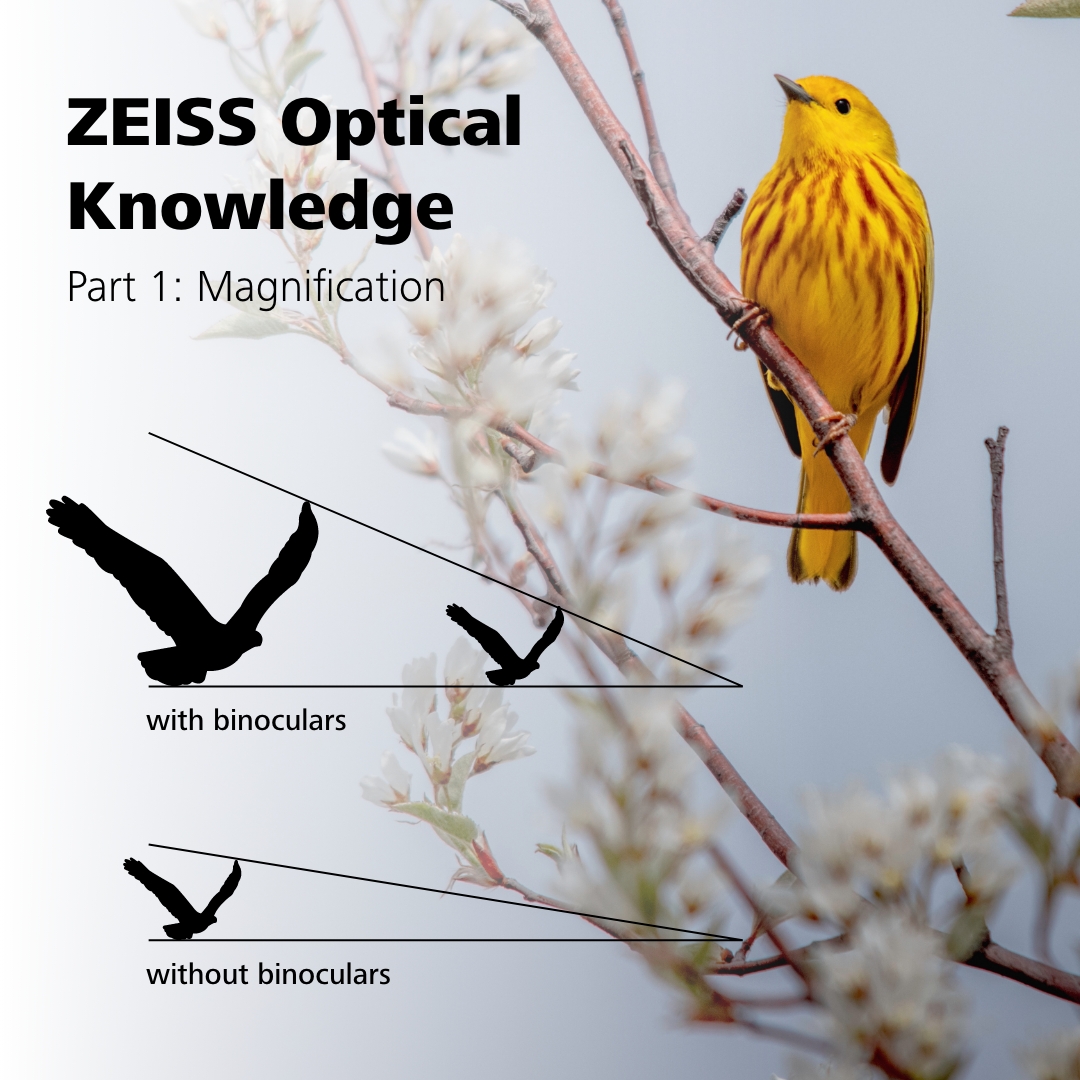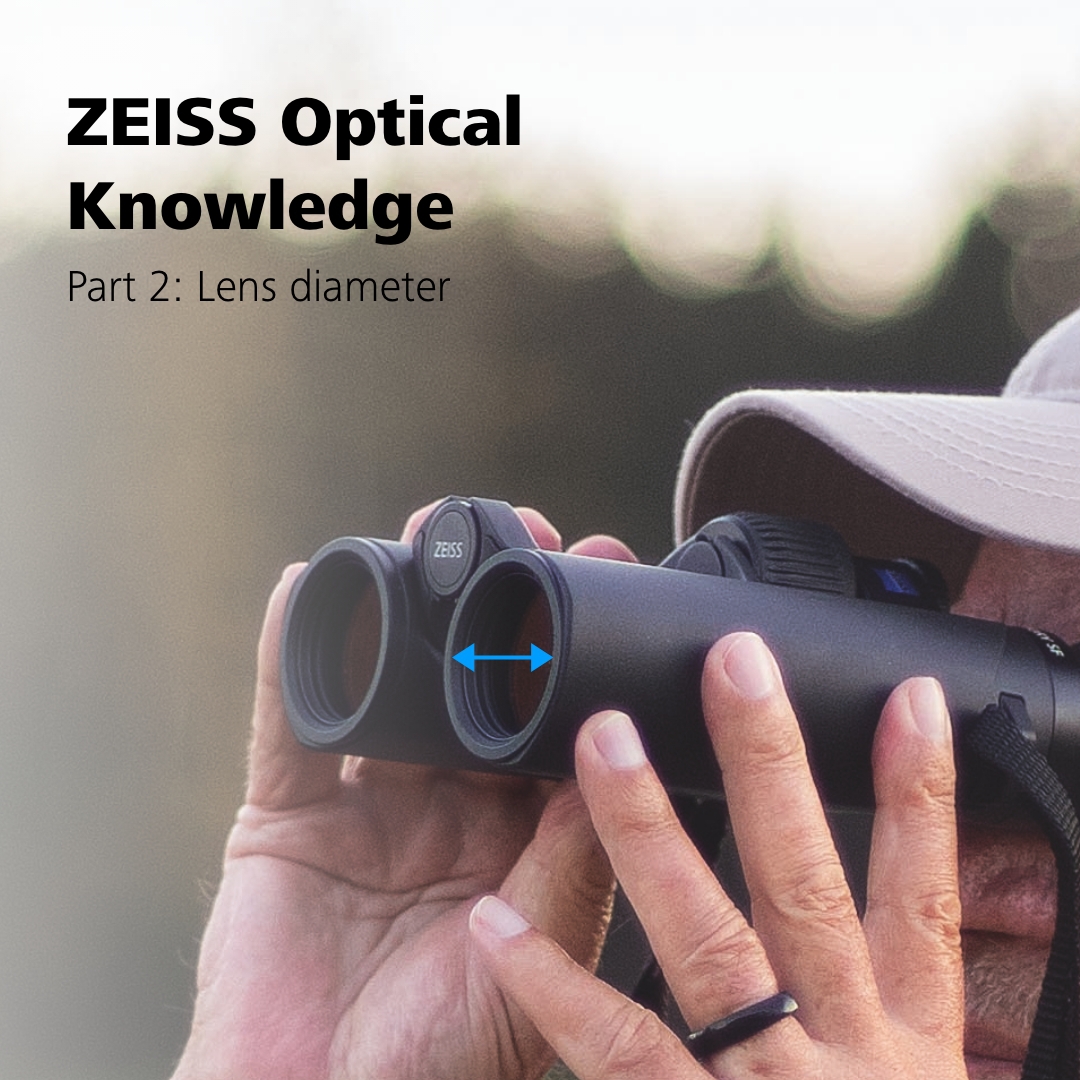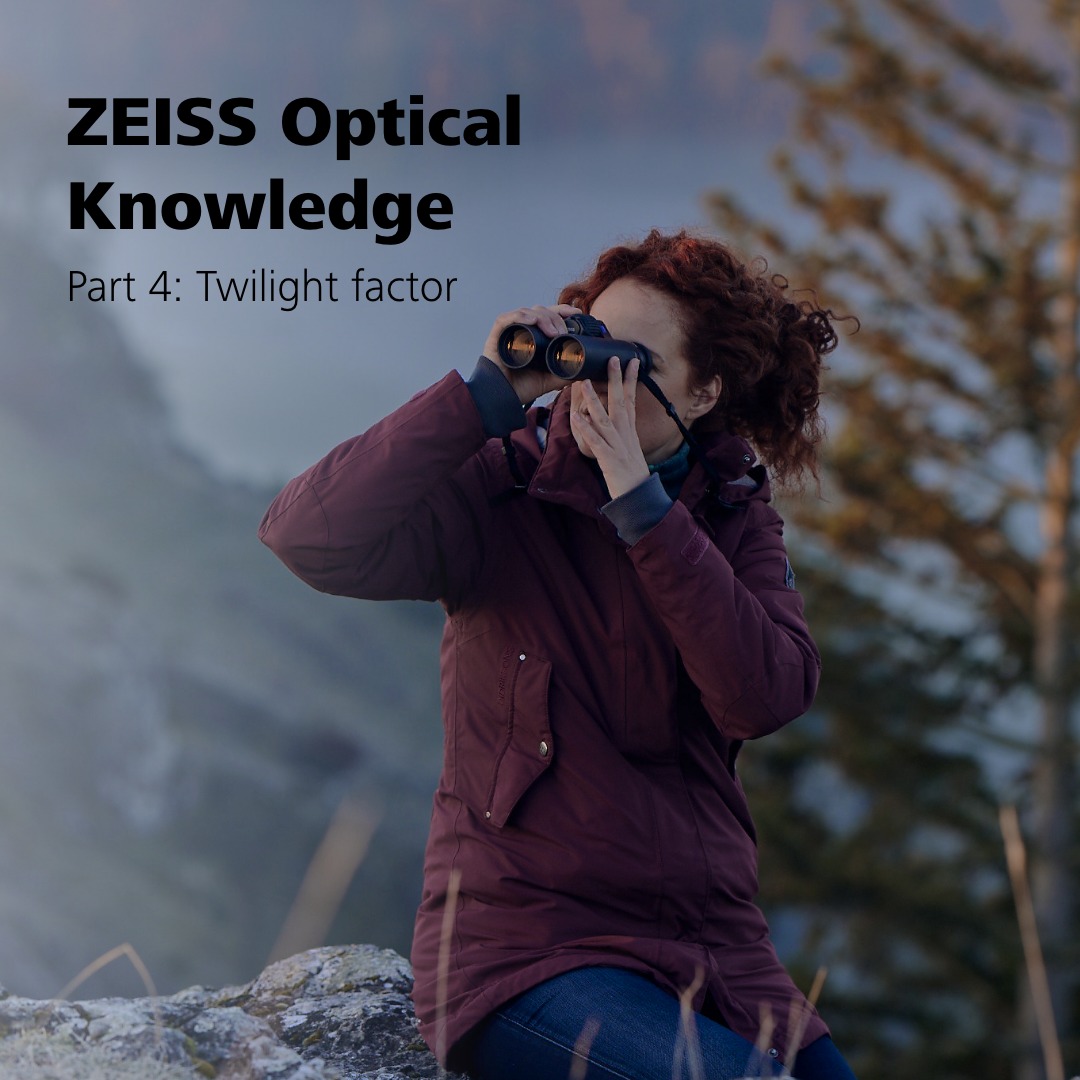In this blog, Zeiss Optics list the most important optical parameters to consider when purchasing or understanding binoculars.
1. Magnification

The first digit in the type designation indicates the magnification factor. With 10x56 binoculars, the observed object appears 10 × larger than with the naked eye. To put it into simpler terms, the distance to the object shrinks by the magnification factor, i.e. a deer 400 m away looks like it is only 40 m away when you look through 10× binoculars.
Two different interpretations:
- The object appears e.g. 10 x larger
- The distance appears e.g. 10 x smaller. The object appears 40 m instead of 400 meters.
For anyone interested in precise mathematical descriptions: the magnification is defined as the ratio between the tangent of the angle at which the height of the object appears with binoculars, to the tangent of the angle at which the height of the object appears without binoculars (see the diagram above). In other words:
M = tan(viewing angle with binoculars) / tan(viewing angle without binoculars)
Typical binoculars for free-hand observation feature 7x or 8x to 10x magnification. Higher magnifications deliver a larger image and, in theory, better detail recognition, but this benefit quickly becomes the opposite due to the effect of hand tremor increasing significantly. This is something that everyone should test themselves. When in doubt, a lower magnification is more enjoyable and the better choice in the long run. Apart from a steadier image, lower magnifications (e.g. 8 x 42 compared to 10 x 42) also offers additional benefits:
- The field of view is larger and you have a better overview of the surroundings.
- The exit pupil is larger, resulting in a brighter image at dawn.
- The depth of field, i.e. the area in the foreground and background that is still perceived as sharply focused, is also larger. You do not have to refocus for minor range changes constantly.
2. Lens diameter

The second digit in the product designation indicates the diameter of the objective lens (that is the lens at the opposite end of the binoculars to the eyepieces) in millimeters. For example, 8 x 56 binoculars have an aperture of 56 mm. The higher this value the more light enters the binoculars. On the flip side, a larger lens diameter also means more weight. However, in recent years, the use of state-of-the-art housing materials and thinner lens elements has resulted in a noticeable reduction in weight.
Unfortunately, on lower-quality binoculars the effective aperture, i.e. the effective entrance pupil, is occasionally much smaller than the stated diameter. This may be due to the small dimensions of the prisms, lens elements, or other components that obstruct the flow of light inside the binoculars. For example, if only 3 mm of the incidental light is cut all around the outer edge of an 8 x 56 model, the effective entrance pupil is 50 mm only. These are now effectively only “8 x 50” binoculars therefore, and have about a 20% smaller light transmission than expected and 20% less light reaches the eye.
3. Exit pupil

In addition to the objective lens aperture, the magnification plays a key role in image brightness. The larger the image on the retina, i.e. the larger the area on which available light is distributed the darker the image.
The key factor is the exit pupil which takes these two effects into consideration. It is the “window” or the “ circular light exit” from which light emerges from the binocular eyepieces. The larger it is the more light that can reach the eye and, therefore, the brighter the image.
The diameter of this exit pupil is calculated on the basis of the following influencing parameters:
Exit pupil = lens diameter / magnification
8 x 56 binoculars includes an exit pupil with a diameter of 7 mm, 10 x 30 binoculars 3 mm only. If you reach out your arm and hold the binoculars against a light surface and look at the eyepiece, you can clearly see the exit pupils. These are absolutely round with crisp edges and evenly bright on high-quality binoculars.
The exit pupil can be interpreted as the diameter of the luminous flux that exits the binoculars. The eye also plays a vital part in the perceivable image brightness: only the part of the luminous flux that enters the eye can contribute to image brightness. If the user’s pupil is only open 2 to 3 mm during the day, the 7 mm exit pupil of 8 x 56 binoculars cannot be fully utilized. The image through an 8 x 56 model is then no brighter than through 3 x 10 binoculars with a 3 mm exit pupil – assuming all other quality features are identical.
To take full advantage of the emerging light intensity of a binocular the eye pupil has to be at least as large as the exit pupil of the binoculars.
The exit pupil remains the decisive factor in suitability for use at dawn and dusk. In this case, the exit pupil on binoculars should be as large as possible but no less than 4 mm. If the exit pupil is larger than the pupil of the eye, the theoretical brightness of the binoculars is not fully utilized but the eye still has a certain amount of flexibility. Despite shaking hands or binoculars not placed exactly in front of the eyes, you still remain “in the picture” literally. The maximum aperture of the eye pupil largely depends on age.
The pupils of children can open up to more than 8 mm, while they seldom exceeds 4 mm in old age.
Average maximum pupil diameter (at night) in relation to age.
While a user’s pupil may only be 2-3mm on a bright day, so they would not be utilizing the full exit pupil of even an 8x32 binocular (4.0mm), it should be remembered that the exit pupils of popular binoculars such as 8x32, 8x42 and 10x42 can still be useful if the day becomes dark due to cloud and rain, or if the user stays out unexpectedly longer, into the twilight of dusk.
4. Twilight factor (TF)

The twilight factor is often used to compare the suitability of binoculars for use in twilight, when less light is available.
The larger the objective lens, the more light enters the binoculars, and the higher the magnification, with the same image brightness, the more details can be observed. So when calculating the twilight factor we must use both objective diameter and magnification.
It is calculated by multiplying the objective lens diameter by the magnification, and obtaining the square root of the result:
TF = √ (magnification x objective lens diameter)
However, the twilight factor is a mere mathematical parameter. It is not possible to include in the calculation the really important aspects of binocular performance such as image quality (including resolution and contrast), light transmission, colour rendition etc...
Every pair of 8 x 42 binoculars, for example, has the same twilight factor – 18.2 – regardless of how good or bad it is in practice, regardless of the brand or price!
The twilight factor can also be completely misleading as shown in the following example: two binoculars, 8 x 56 and 56 x 8 (such a model does not exist but would be theoretically possible), have an identical twilight factor of 21.2. While an 8 x 56 model is ideal during twilight, a 56 x 8 pair would be totally unusable, even in daylight. Therefore the twilight factor alone does not offer any kind of useful guidance.
A large exit pupil is always the most decisive and important factor for twilight use. Ideally, it should be at least as large as the pupil of the user. Anything with an exit pupil smaller than 4 mm is, therefore, unsuitable in twilight right from the start – even if the twilight factor is high.
Finally, if the binocular is of high optical quality, and the exit pupil is at least 4.0mm, and the observer is able to hold the binocular steady or have it supported in some way, a 10 x binocular will reveal more details during twilight than an 8x model.
Just, when comparing binoculars of the same quality and the same objective diameter, i.e. 8x42 and 10x42, this will reveal that although the twilight factor of the 10x42 – 20.5 - is higher, the image of the 8x42 indeed is brighter.
The reason for this is simple to explain: With the same objective size, both binoculars gather the same amount of light, but with the higher magnification, this light is distributed on a larger area of the retina, and thus the light intensity for the single receptors of the eye is lower.
5. Field of view

The field of view describes the diameter of the circular view seen when looking through the optics. For example, if you look at the edge of a forest through binoculars at a distance of 1,000 m and see an area that is 120 m in diameter, the binoculars have a field of view of 120 m at 1,000 m.
The size of the field of view indicates how many metres wide on 1000m can be seen through the binoculars.
Occasionally, the viewing angle or objective viewing angle is given, e.g. 6°. The field of view and viewing angle can be easily calculated:
The field of view depends on the optical design of the binoculars but especially on the magnification, i.e. in general, lower magnification binoculars have a larger field of view than binoculars with higher magnification, although there are exceptions.
Very small fields of view can give the impression of looking through a tunnel. There is a lot of black on the outside and a small image area in the middle. This characteristic creates a rather unpleasant viewing experience which is best avoided.
If the field of view is very small, there is the impression of a tunnel vision.
Wide angle binoculars, on the other hand, deliver very large fields of view that not only provide a wide overview but also comfortable, pleasant observation.
If the field of view is so large that the image circle appears to have an angle of 60° or higher, then the binocular is considered to be a ‘wide- angle’ model according to the ISO norm/standard. This angle at which the image is observed in the eyepiece, is the subjective or ‘apparent’ viewing angle.
Is a field of view, e.g. 120 m at 1,000 m, good or bad for binoculars? The answer depends on the magnification. 10x binoculars with this field of view would be very good (subjective viewing angle approx. 69°), a 7x pair with this field of view would be rather weak (subjective viewing angle of 48° only). Notice how the subjective viewing angle shows immediately if the field of view is pleasantly large and comfortable, or if tunnel vision can be expected.
The field of view cannot be calculated from the simple format information (e.g. 10 x 42) but is determined by the optical design. The size of the prisms and the eyepiece determine the image angles that can pass through the binoculars. The objective lens diameter does not affect this and it only influences the brightness.
When comparing fields of view based on the linear measurement at 1,000 metres, remember that the view through the binoculars is a circle so only a modest increase in the diameter can be a significant one if you consider the area of the circle in square metres. For example, an increase of less than 10% in the linear measurement/diameter from 135 m to 148 m (a 9.6% increase) actually results in an increase in the area of view from 14,316 square metres to 17,201, an increase of 20%.
When comparing the edge definition of different binoculars, it is necessary to not only use the same format (e.g. 10 x 42) only, but also take the fields of view into consideration. If one pair has a field of view of 120 m and another only 100 m at 1,000 m, it is easier for the second to have better edge definition. However, this “benefit” comes with a considerable loss of field of view.
A wide field of view is very useful for many kinds of nature observation including scanning large areas of sky for hawks and eagles, or areas of water for whales and dolphins or re-surfacing diving birds such as ducks or divers (loons), and for capturing views of nearby fast-flying subjects such as warblers and butterflies or dragonflies.






